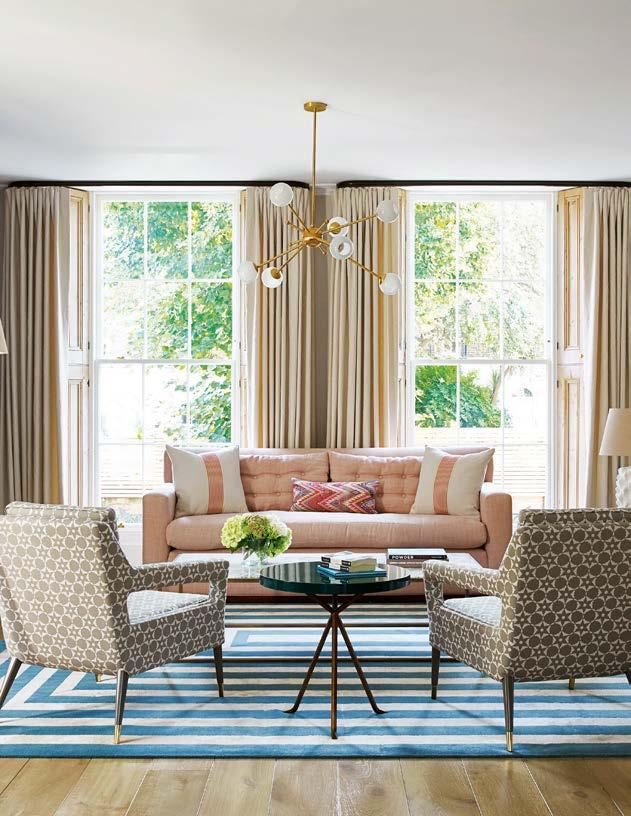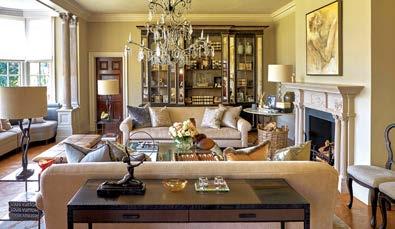
14 minute read
Plant Focus Ian Roger, holder of the
Spring-flowering bulbs like snowdrops, daffodils and anemones are the stalwarts of a woodland garden, but if you want something a little bit more choice to add to the mix, look no further than erythroniums. Also known as dog’s tooth violets because the white, elongated bulbs resemble canine fangs, these woodland stars, a member of the lily family, are the epitome of garden elegance, with slender upright stems topped by exotic-looking flowers held above clumps of broad, wavy leaves that are often beautifully patterned. When the flowers first emerge, they dangle from the stems like Tiffany lampshades. But in sunshine, the petals curve backwards to encourage pollinators to visit, and the
Above Mingling with Primula elatior, a pink Erythronium revolutum hybrid makes for a charmingly pastel spring scene. blooms then more closely resemble Turk’s cap lilies.
There are believed to be between 25 and 30 species of erythronium spread across temperate parts of North America, Europe and Asia, which can be split into two distinct groups: the Eurasian species and those from North America. “The American varieties are woodland plants, so they need a slightly more acidic soil, dappled shade and leafmould,” explains Ian Roger, managing director of North Yorkshire-based plant centre and nursery RV Roger, which is home to the Plant Heritage National Collection of Erythroniums. “The Eurasian ones, they’re from alpine, meadow or woodland margin habitats and will take more sunshine and a neutral pH. A moisture-retentive but free-draining soil is important for both types but, in general, erythroniums aren’t overly fussy and are fairly forgiving plants. Once they’re in, they’re easy to look after and bone hardy; you can forget about them and they’ll just keep coming back and gradually spread,” says Ian.
Spring gems
Erythronium hybrids and cultivars are more vigorous, floriferous and tolerant of a wider range of conditions than the species, and they’ll also form bigger clumps more quickly. This ease and speed of growth means some are more widely available than others. “Erythroniums such as ‘Pagoda’ and ‘White Beauty’ are a good place to start,” says Ian. ‘Pagoda’, which has an RHS AGM, is probably the easiest to come by and bears large, zesty, yellow blooms above bronze-and-green mottled foliage. At 45cm it’s taller than most erythroniums, so it makes more of a show. It also clumps up quickly and is easy to grow, although it’s not quite as delicate as some. If you’re not keen on yellow then ‘White Beauty’, which also holds an AGM, is smaller, growing to about 30cm, with exquisite ivory flowers that have pale lemon centres and maroon markings.
The colour range for erythroniums is white and shades of yellow and pink. “Pink is the most desirable among collectors because it’s the scarcest colour among the American species,” explains Ian.



Left The European species Erythronium dens-canis has dainty flowers in lilac-pink, with reflexed flowers reminiscent of cyclamen. Below left The maroon stems and yellow blooms of reliable ‘Pagoda’. Below right ‘White Beauty’ soon bulks up to form good-sized clumps. Bottom Mauve wood anemones, A. nemorosa, make an excellent partner in light shade.

He recommends ‘Kinfauns Pink’, a hybrid between E. californicum ‘White Beauty’ and E. revolutum, which was raised in Scotland by Pitcairn Alpines. It has maroon stems, pretty pale-pink flowers and marbled foliage and grows to about 20cm. ‘Craigton Cover Girl’ is another good pink, but it’s rare and available only from specialist growers.
Beyond the hybrids are the more delicate species such as E. dens-canis, the European dog’s tooth violet, whose petals reflex fully in spring sunshine, so much so they look like cyclamen. It grows to about 20cm, and the rose-pink blooms, splashed with rusty orange in the centre, make a striking contrast against the orange-red stems and the attractive green-and-brown blotched leaves. The tiny, lilac-coloured E. japonicum has slender, pointy petals that fold backwards like an origami bird. But



one of the most eye-catching is E. americanum. It’s only 10cm, with stunning yellow flowers tinged a coppery colour to match the stems, which sit above heavily mottled leaves, all of which combine to make a dramatic sight when grown en masse.
Propagation
Erythroniums multiply underground, producing small bulbils; vigorous hybrids and species will form good-sized clumps within a couple of years, but the slower-growing species will take longer. By removing seedpods when they form, you can encourage the bulbs to grow and spread more quickly.
They can be left to naturalise but, as with other bulbs, they’ll benefit from being lifted and divided every three to five years. Above A drift of Lift clumps and split into Erythronium revolutum with fellow woodlander, small sections by teasing Hacquetia epipactis. the bulbs apart. Take Left E. x revolutum care as the bulbs can be ‘Elizabeth’ has delicate, quite brittle and are easily pink-tinged petals. Far left Copper-tinted damaged. Ian suggests flowers and mottled dividing them in August leaves of E. americanum. so the roots can become
established while the soil is still warm and there is moisture from autumn rain. There’ll be no foliage above ground at this point in the year, so make sure you mark where they’re growing in spring so you can find them in the summer.
Some species, such as E. oregonum, can only be propagated by seed, but to produce a flowering plant can take seven to eight years. For this reason they are rarely for sale and, if they are, they’re more expensive than the more easily reproduced hybrids.

Planting partners
Erythroniums emerge from the ground in February and bloom from March into April, with the foliage dying down completely in June and the bulbs becoming dormant over summer. This means it’s important to consider what you plant with them so they have space to shine in spring and to avoid gaps in planting and patches of bare soil in summer.
Spring companions include fellow woodlanders, such as rhododendrons, primula, trillium, uvularia, brunnera and delicate ferns such as Polystichum tsussimense. Ian suggests Solomon’s seal, which would flower a bit later to continue the spring interest, and tellima. “The key is to avoid vigorous plants that could swamp the erythroniums,” he says.
For summer plants that will plug the gap left as the erythroniums retreat underground, look to Geranium nodosum ‘Silverwood’, which has a compact habit, dainty ferns like the Japanese painted fern (Athyrium niponicum var. pictum) or tiarella, with their attractive foliage and flower spikes. n
GROWING ADVICE Planting & Care
Ian Roger shares the tips and tricks he uses to successfully grow erythroniums
Don’t overfeed because the growth will get too soft. We scatter hoof and horn or bonemeal as we replant in August or September and then, ideally, again after Christmas.
A leafmould mulch in autumn helps to build up a deep, friable soil structure similar to that of a woodland floor.
There are few pest and disease problems. Slugs and snails can cause minor damage and we have to keep out pheasants. Occasionally squirrels attack but that isn’t erythronium specific, they’ll go for any bulbs! The bulbs don’t store well once out of the ground, so you need to get hold of freshly dug ones from a specialist grower like ourselves, who’ll dispatch them straight away in damp packaging, rather than buying the dried bulbs that come in packets from the garden centre. We harvest our bulbs in summer, grade them, take out those needed for orders and then replant the main plant, all in one process. Alternatively, instead of buying bulbs, buy potted specimens from nurseries or garden centres in spring, when they’re in growth.
Above E. tuolumnense ‘Spindlestone’, nicely partnered with blue grape hyacinths. Right Beautifully reflexed flowers of Erythronium revolutum, held above handsome, burgundy marbled leaves.

NEW DECORATING GUIDE
INTERIOR DESIGN2021 DESIGN GUIDE CREATING THE PERFECT ENGLISH HOME



PROFESSIONAL DESIGN ADVICE
Kitchens Bathrooms Sitting rooms Dining rooms Home offices Dressing rooms
PLUS
Chic shortcuts & wise buys Essential resources & brilliant tips Serene SITTING ROOMS



Four top interior designers reveal what to consider when designing a stylish sitting room with enduring appeal
Personal style and architectural considerations are priorities when considering the design and layout of a sitting room. However, function is undeniably an important factor too – where some may require a sleek, elegant space for evening drinks and entertaining, others may need a family-friendly room where different generations can come together and relax in each other’s company. How best then to blend these varying elements? We talk to leading designers to glean insights on key projects of theirs and highlight stylish and effective solutions.
Louise Bradley on combining a contemporary aesthetic with a period property
Interior designer Louise Bradley provides insights on fulfilling a brief to create a luxurious, contemporary setting that was sympathetic to the history of a Grade II listed property.
The brief “The main house at the estate – a 130-acre shooting and fishing estate in Surrey – is Grade II listed and was designed by Scottish architect JM Brydon in 1885 as his own home. The sitting room boasts large windows and ample natural light, and is the main space within which the family gathers and hosts their friends. The client’s brief was for a classic-contemporary aesthetic that also fitted with the history of the house.”
14
THE ENGLISH HOME Past and present ABOVE “Working with a Grade II listed property sometimes The bespoke has its challenges, with many existing features needing ornate breakfront bookcase along to be retained throughout the interior architecture of the far wall is the building. The clients wanted an elegant yet designed to comfortable drawing room in which they could relax complement the and entertain family and friends, with a classic style and history of the property contemporary-feel decor that was also sympathetic and echoes to the history of the estate. architectural
“We retained the original floor, the original columns elements in and fireplace. The beautiful large bay window had the room. amazing views over the gardens so it was important to look at a floor plan and colour scheme that made the most of the spectacular gardens; to achieve this, we opted for soft muted colours that would complement
TEH UK Bookazine 2021 Sitting room case study.indd 14-15
BATHROOMS
Blissful BATHROOMS Design experts reveal important considerations in balancing style and practicality to create the ideal bathroom Case Study One

SITTING ROOMS Case Study One

the different seasons. Under the bay window, we made a large comfortable window seat that offered an area to relax, dressed with a variety of bespoke cushions using different textures and patterns, perfect to recline amidst for morning coffee and papers. The comfortable contemporary sofas were upholstered in a soft chenille and again dressed with cushions in assorted traditional prints. Cushions always add an element of luxury allowing to add colour without overpowering the room.”
Creating a blend “The choice of a coffee table with clean lines and an aged mirror top had a more contemporary feel, dressed with interesting books and accessories adding interest Gemma Gordon-Duff on creating a decadent en suite Interior designer Gemma Gordon-Duff, of architectural interior design practice Gordon-Duff & Linton, reveals how she created a luxurious central London master suite with decadent materials and unfussy design details to create a scheme with a difference. The brief “My client’s main residence is outside the UK and so, as this home is used intermittently, they wanted the master suite – bedroom, dressing room and bathroom – to have all the luxuries of a hotel, but with a more homely feel. They loved the decadence of a copper bath in the dressing room, and asked us to use this as the starting point for the design. The property is a handsome Georgian townhouse, with high ceilings and beautiful architectural features, and so another aim was to complement this feeling of grandeur with a suitably classic yet chic design.” to the space. A central chandelier was a must and completed the overall aesthetic. The occasional table lamps, in both metal and rock crystal, created another level of light to the room in the evenings. The large bespoke breakfront bookcase was made by one of our trusted artisan craftsmen and is designed in a traditional style with a specialist paint finish in aged black, with an antique mirror detail in the pilasters to add interest. It also allows the clients to display their books, objets d’art collected over the years on their travels and family photographs.”
RIGHT The simple design and clean lines of the coffee table create a perfect setting for a carefully curated selection of
THE ENGLISH HOME
15

27/10/2020 15:39


ORDER
Bathrooms, as intimate, personal spaces, have to be functional and hard-wearing yet also provide a cocoonlike and indulgent zone where we can close the door and feel at peace. It is vitally important, therefore, to get the feel right, particularly as warmth, comfort and a sense of luxury are bound to be high on the list of priorities. So the question is how to marry the brisk efficiency necessary for the early

86 THE ENGLISH HOME OVER 30 INTERIOR DESIGNER CASE STUDIES BY Nina Campbell, Joanna Wood, Jane Churchill, Paolo Moschino, TEH UK Bookazine 2021Bathroom case studySSJamends.indd 86-87TODAY FOR Susie Atkinson, Emma Sims-Hilditch & many, many more...ONLY $14.45

morning rush with the pleasure of a relaxing evening bath or a long, hot shower?
Here, our bathrooms special showcases a range of rooms by four experienced designers, each demonstrating that it is eminently possible to marry form and function and create a space which is both perfectly practical and a beautiful haven in which to refresh and unwind.
Bookazine US COVER 2021 final.indd 1 23/10/2020 12:25
books and mementoes. Luxury & opulence “The perfect place for the bath was by the window in the dressing room, with a cream linen Roman blind for privacy. I chose copper because the client expressed a desire for a statement piece and, to elevate the experience (and to allow for possible water splashes), raised the bath on an Arabescato marble plinth. The room is finished with a luxurious, cut-pile velvet carpet. Next to the bath, I designed an oversized ottoman in a sage cotton velvet that allows for clothes to be laid out, or for a partner to sit and chat. I do feel that bathing in a room full of soft, luxurious fabrics is a lovely, serene and elegant way to relax and cleanse. I designed wardrobe doors with a copper inlay to complement the bath.
The en suite has plenty of space for a shower and vanity unit. I continued the opulent theme by using the same Arabescato marble on the walls, floor and even the drawer fronts. Above the vanity, wall-mounted taps create clean lines and allow plenty of space for toiletries, and a shallow mirror-fronted storage unit has inset lighting concealed beneath. The oversized, walk-in shower with a wet-room floor ensures the room feels spacious but unfussy. The finishing touch is low-level lighting in the bathroom that is automatically triggered by movement at night. The overall effect is luxurious but also quite architectural.”
OPPOSITE PAGE & ABOVE RIGHT A copper bath from Catchpole & Rye is raised to window height by being set on a marble plinth in the dressing room. The wardrobe doors feature a copper inlay to echo the bath’s exterior; they were designed by Gordon-Duff & Linton. The silver- framed bird paintings are from Oka. ABOVE LEFT The walls, floor and drawer fronts of the en-suite shower room are covered with beautifully grained Arabescato marble from Stone of London.
THE ENGLISH HOME
87

27/10/2020 15:40
Interior Design is the ultimate room-by-room guide dedicated to helping readers create their dream home. From the publishers of The English Home magazine, it features invaluable advice from some of Britain’s finest designers and interiors experts on choosing all the key elements that make a house an elegant home.
Buy online for $14.45 (including shipping and handling) and have it delivered direct to your door. Visit chelseamagazines.com/interiordesign21
Precision Planning
At Morton Hall in Worcestershire, Anne Olivieri and her team plant thousands of bulbs each autumn for the popular Tulip Festival with meticulous care. Here she shares her techniques for creating gorgeous displays
PHOTOGRAPHS CLIVE NICHOLS

With carefully perfected displays, Morton Hall's Tulip Festival showcases the best of these bulbs.







